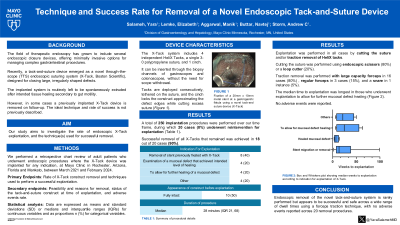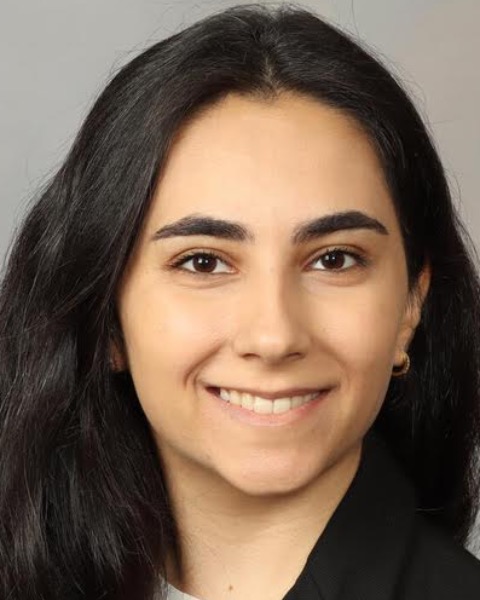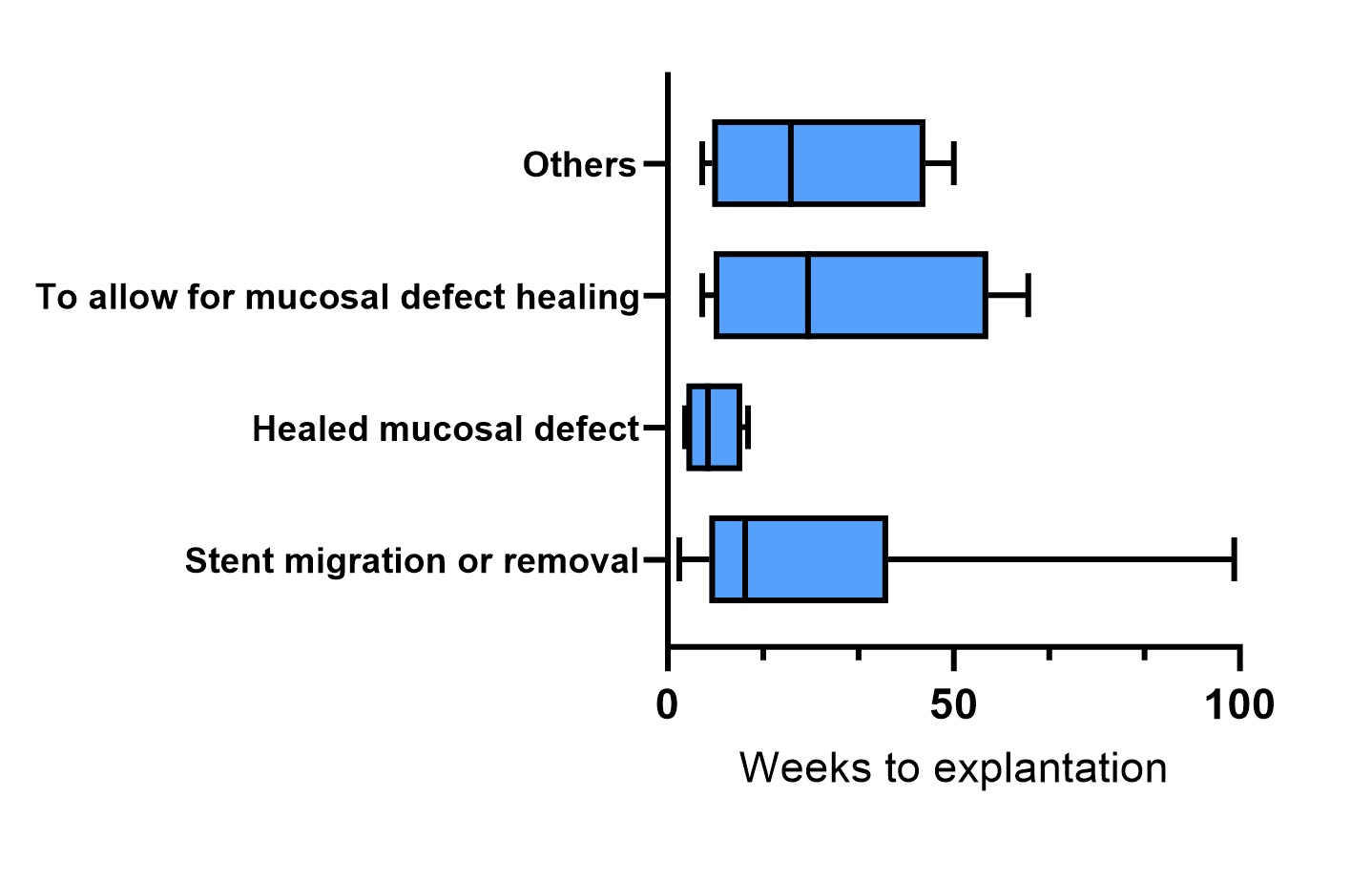Monday Poster Session
Category: Interventional Endoscopy
P2761 - Technique and Success Rate for Removal of a Novel Endoscopic Tack-and-Suture Device
Monday, October 28, 2024
10:30 AM - 4:00 PM ET
Location: Exhibit Hall E

Has Audio

Yara Salameh, MD
Mayo Foundation for Medical Education and Research
Rochester, MN
Presenting Author(s)
Yara Salameh, MD1, Elizabeth Lemke, BA2, Manik Aggarwal, MBBS2, Navtej Buttar, MD2, Andrew Storm, MD2
1Mayo Foundation for Medical Education and Research, Rochester, MN; 2Mayo Clinic, Rochester, MN
Introduction: The field of therapeutic endoscopy has grown to include several endoscopic closure devices, offering minimally invasive options for managing complex gastrointestinal procedures. Recently, a tack-and-suture device emerged as a novel through-the-scope (TTS) endoscopic suturing system (X-Tack, Boston Scientific), designed for closing large, irregularly shaped defects. The implanted system is routinely left to be spontaneously extruded after intended tissue healing secondary to gut motility. However, in some cases a previously implanted X-Tack device is removed on follow-up. The ideal technique and rate of success is not previously described. Our aim was to investigate the rate of endoscopic X-Tack explantation and the technique(s) for successful removal.
Methods: A retrospective chart review of adult patients who underwent any endoscopic procedure where the tack-and-suture device was implanted at Mayo Clinic between March 2021 and February 2024. Primary outcomes were rate of X-Tack removal and techniques of explantation. Secondary outcomes included feasibility and reasons for removal, status of tack-and-suture at explantation time, and adverse event rate.
Results: Out of a total of 250 implantation procedures, 20 underwent reintervention and attempted explantation. Indications for X-Tack explantation were removal of a stent previously fixated with tack and suture (40%, N=8), examination of a mucosal defect that has achieved intended level of healing (20%, N=4), to allow for further healing of a mucosal defect (20%, N=4), and “other” (20%, N=4). Explantation was performed in all cases by cutting the suture and/or traction removal of the HeliX tacks. Endoscopic scissors (80%) or a loop cutter (20%) were used to cut the suture. For traction removal of tacks, large capacity forceps were used in 16 cases, regular forceps in 3 cases, and a snare in 1 instance. X-Tacks were explanted after a median time of 13.5 weeks (IQR 6.25, 33.75) from implantation date, with half the cases confirmed to have a fully intact X-tack construct. Successful removal of all X-Tacks that remained was achieved in 18 out of 20 cases. Median procedure duration was 28 minutes (IQR 21, 68) with no adverse events reported.
Discussion: Endoscopic removal of the novel tack-and-suture system is rarely performed, but appears to be successful and safe across a wide range of dwell times using a forceps traction technique, with no adverse events across 20 removal procedures.

Disclosures:
Yara Salameh, MD1, Elizabeth Lemke, BA2, Manik Aggarwal, MBBS2, Navtej Buttar, MD2, Andrew Storm, MD2. P2761 - Technique and Success Rate for Removal of a Novel Endoscopic Tack-and-Suture Device, ACG 2024 Annual Scientific Meeting Abstracts. Philadelphia, PA: American College of Gastroenterology.
1Mayo Foundation for Medical Education and Research, Rochester, MN; 2Mayo Clinic, Rochester, MN
Introduction: The field of therapeutic endoscopy has grown to include several endoscopic closure devices, offering minimally invasive options for managing complex gastrointestinal procedures. Recently, a tack-and-suture device emerged as a novel through-the-scope (TTS) endoscopic suturing system (X-Tack, Boston Scientific), designed for closing large, irregularly shaped defects. The implanted system is routinely left to be spontaneously extruded after intended tissue healing secondary to gut motility. However, in some cases a previously implanted X-Tack device is removed on follow-up. The ideal technique and rate of success is not previously described. Our aim was to investigate the rate of endoscopic X-Tack explantation and the technique(s) for successful removal.
Methods: A retrospective chart review of adult patients who underwent any endoscopic procedure where the tack-and-suture device was implanted at Mayo Clinic between March 2021 and February 2024. Primary outcomes were rate of X-Tack removal and techniques of explantation. Secondary outcomes included feasibility and reasons for removal, status of tack-and-suture at explantation time, and adverse event rate.
Results: Out of a total of 250 implantation procedures, 20 underwent reintervention and attempted explantation. Indications for X-Tack explantation were removal of a stent previously fixated with tack and suture (40%, N=8), examination of a mucosal defect that has achieved intended level of healing (20%, N=4), to allow for further healing of a mucosal defect (20%, N=4), and “other” (20%, N=4). Explantation was performed in all cases by cutting the suture and/or traction removal of the HeliX tacks. Endoscopic scissors (80%) or a loop cutter (20%) were used to cut the suture. For traction removal of tacks, large capacity forceps were used in 16 cases, regular forceps in 3 cases, and a snare in 1 instance. X-Tacks were explanted after a median time of 13.5 weeks (IQR 6.25, 33.75) from implantation date, with half the cases confirmed to have a fully intact X-tack construct. Successful removal of all X-Tacks that remained was achieved in 18 out of 20 cases. Median procedure duration was 28 minutes (IQR 21, 68) with no adverse events reported.
Discussion: Endoscopic removal of the novel tack-and-suture system is rarely performed, but appears to be successful and safe across a wide range of dwell times using a forceps traction technique, with no adverse events across 20 removal procedures.

Figure: Box and Whiskers plot showing median weeks to explantation according to indication for removal of X-Tack.
Disclosures:
Yara Salameh indicated no relevant financial relationships.
Elizabeth Lemke indicated no relevant financial relationships.
Manik Aggarwal indicated no relevant financial relationships.
Navtej Buttar indicated no relevant financial relationships.
Andrew Storm: Apollo Endosurgery – Consultant, Grant/Research Support. Boston Scientific – Consultant, Grant/Research Support. Enterasense – Grant/Research Support. Intuitive Surgical – Consultant. Olympus – Consultant. SofTac – Grant/Research Support.
Yara Salameh, MD1, Elizabeth Lemke, BA2, Manik Aggarwal, MBBS2, Navtej Buttar, MD2, Andrew Storm, MD2. P2761 - Technique and Success Rate for Removal of a Novel Endoscopic Tack-and-Suture Device, ACG 2024 Annual Scientific Meeting Abstracts. Philadelphia, PA: American College of Gastroenterology.
